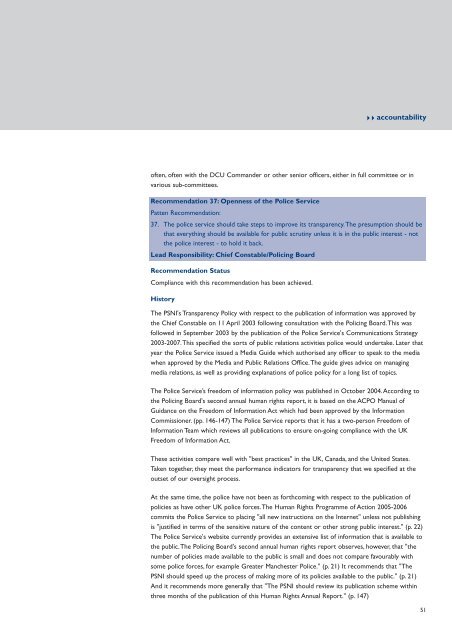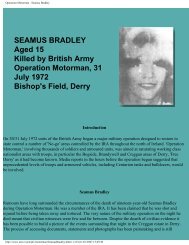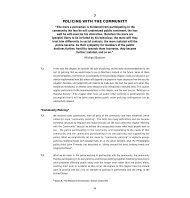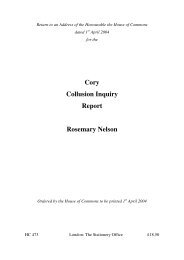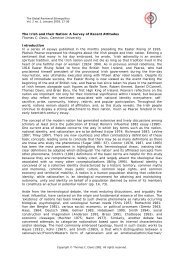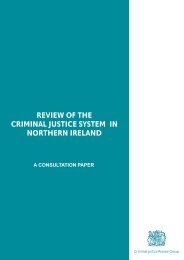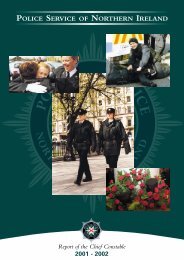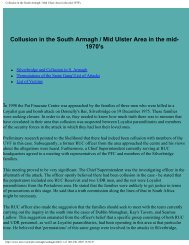11293 report 19 - CAIN - University of Ulster
11293 report 19 - CAIN - University of Ulster
11293 report 19 - CAIN - University of Ulster
Create successful ePaper yourself
Turn your PDF publications into a flip-book with our unique Google optimized e-Paper software.
accountability<strong>of</strong>ten, <strong>of</strong>ten with the DCU Commander or other senior <strong>of</strong>ficers, either in full committee or invarious sub-committees.Recommendation 37: Openness <strong>of</strong> the Police ServicePatten Recommendation:37. The police service should take steps to improve its transparency.The presumption should bethat everything should be available for public scrutiny unless it is in the public interest - notthe police interest - to hold it back.Lead Responsibility: Chief Constable/Policing BoardRecommendation StatusCompliance with this recommendation has been achieved.HistoryThe PSNI's Transparency Policy with respect to the publication <strong>of</strong> information was approved bythe Chief Constable on 11 April 2003 following consultation with the Policing Board.This wasfollowed in September 2003 by the publication <strong>of</strong> the Police Service's Communications Strategy2003-2007.This specified the sorts <strong>of</strong> public relations activities police would undertake. Later thatyear the Police Service issued a Media Guide which authorised any <strong>of</strong>ficer to speak to the mediawhen approved by the Media and Public Relations Office.The guide gives advice on managingmedia relations, as well as providing explanations <strong>of</strong> police policy for a long list <strong>of</strong> topics.The Police Service’s freedom <strong>of</strong> information policy was published in October 2004.According tothe Policing Board's second annual human rights <strong>report</strong>, it is based on the ACPO Manual <strong>of</strong>Guidance on the Freedom <strong>of</strong> Information Act which had been approved by the InformationCommissioner. (pp. 146-147) The Police Service <strong>report</strong>s that it has a two-person Freedom <strong>of</strong>Information Team which reviews all publications to ensure on-going compliance with the UKFreedom <strong>of</strong> Information Act.These activities compare well with "best practices" in the UK, Canada, and the United States.Taken together, they meet the performance indicators for transparency that we specified at theoutset <strong>of</strong> our oversight process.At the same time, the police have not been as forthcoming with respect to the publication <strong>of</strong>policies as have other UK police forces.The Human Rights Programme <strong>of</strong> Action 2005-2006commits the Police Service to placing "all new instructions on the Internet" unless not publishingis "justified in terms <strong>of</strong> the sensitive nature <strong>of</strong> the content or other strong public interest." (p. 22)The Police Service's website currently provides an extensive list <strong>of</strong> information that is available tothe public.The Policing Board's second annual human rights <strong>report</strong> observes, however, that "thenumber <strong>of</strong> policies made available to the public is small and does not compare favourably withsome police forces, for example Greater Manchester Police." (p. 21) It recommends that "ThePSNI should speed up the process <strong>of</strong> making more <strong>of</strong> its policies available to the public." (p. 21)And it recommends more generally that "The PSNI should review its publication scheme withinthree months <strong>of</strong> the publication <strong>of</strong> this Human Rights Annual Report." (p. 147)51


